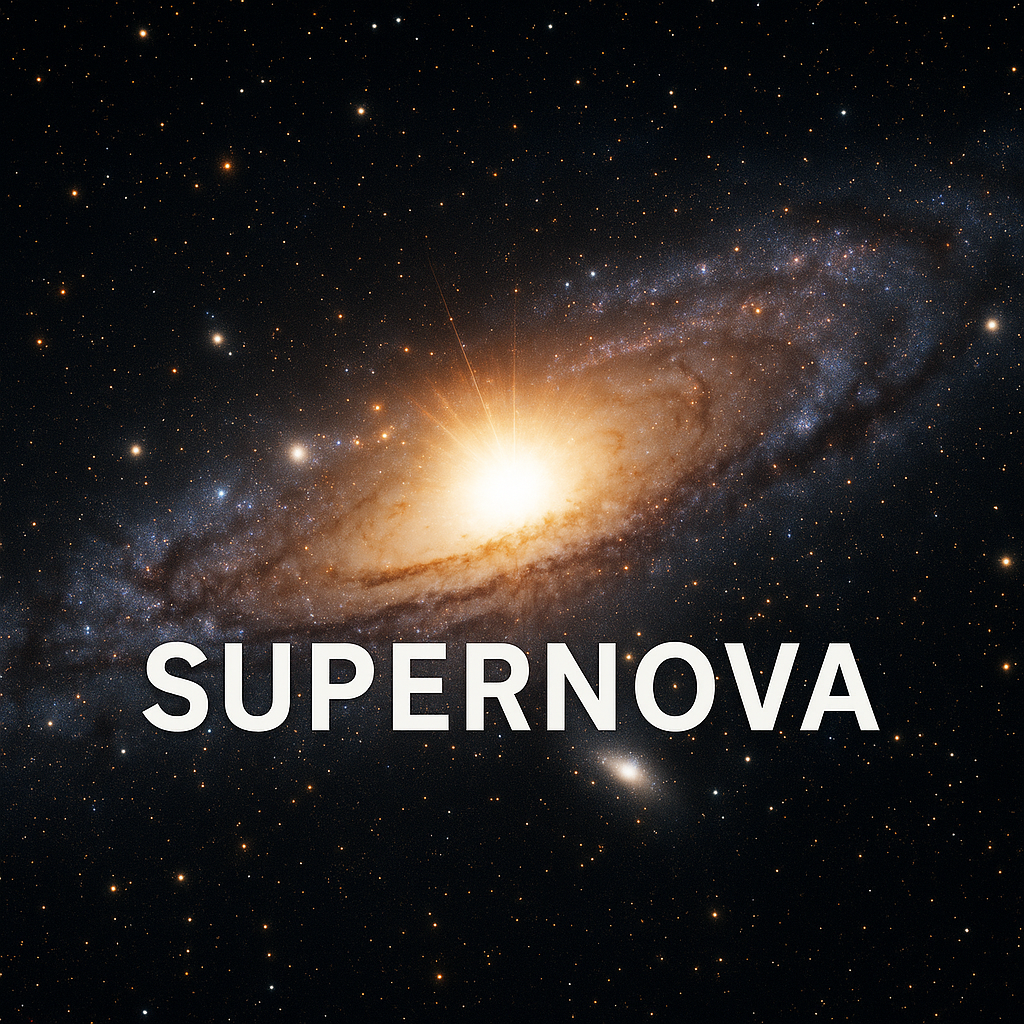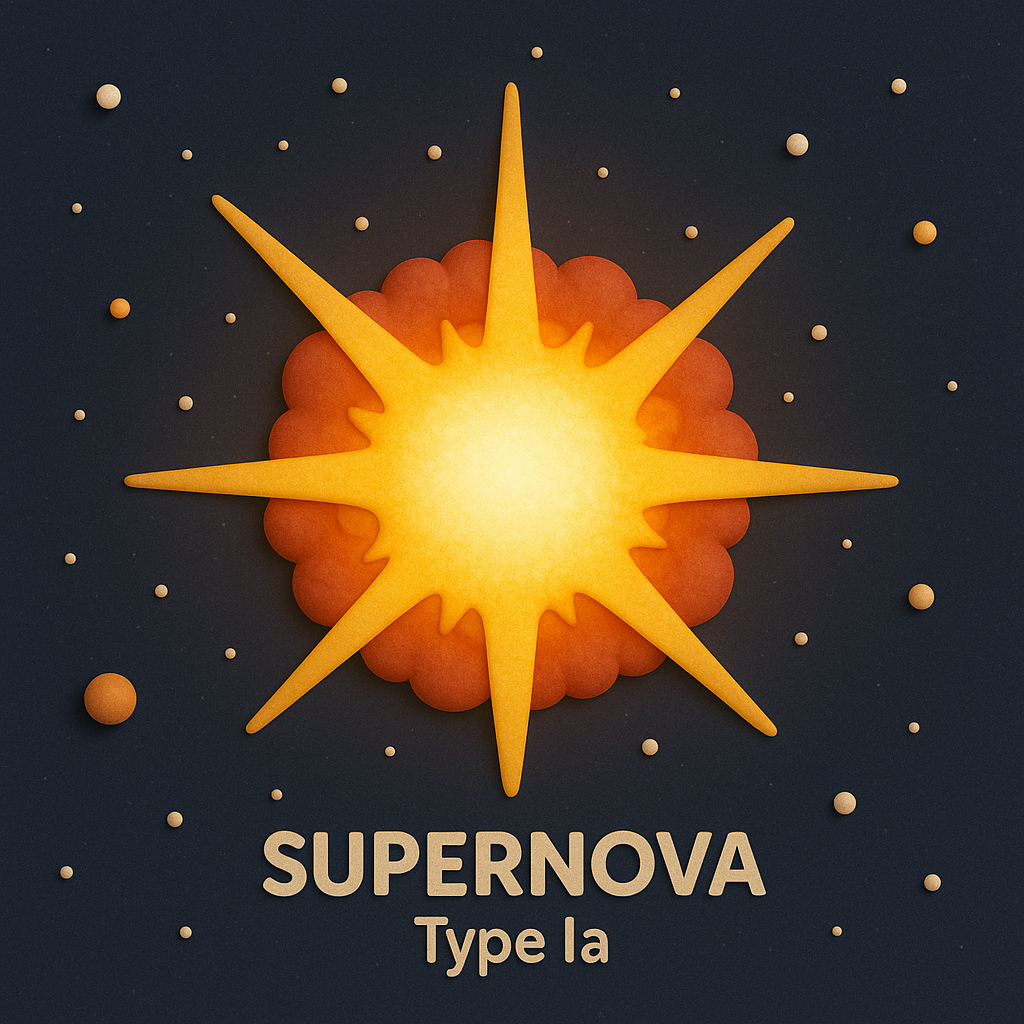Supernova
Definition
Supernova is a noun meaning a catastrophic stellar explosion that dramatically increases a star’s brightness for a short period, ejects most of its mass at high velocity, and forges heavy elements; by extension, it can refer to the star undergoing such an explosion or, figuratively, to someone/something that rises to intense prominence and fades quickly.
Parts of Speech
- Noun (often used attributively: “supernova remnant”)
Pronunciation
American English
- IPA: /ˌsuːpərˈnoʊvə/
- Respelling: SOO-pər-NOH-və
British English
- IPA: /ˌsuːpəˈnəʊvə/
- Respelling: SOO-pə-NOH-və
Etymology
Modern scientific Latin from super “above, beyond” + nova (stella) “new (star),” modelled on nova (a “new star”). The label supernova was popularized in early 20th-century astronomy to distinguish these far more energetic explosions from ordinary novae.
Derivatives
- supernovae /suːpərˈnoʊviː/ (plural; also supernovas)
- supernova remnant (SNR) (noun) — the expanding shell of gas and dust left after the explosion
- supernova rate (noun phrase)
- supernoval (adjective; rare) — relating to a supernova
Synonyms
- stellar explosion
- stellar cataclysm
- starburst (loose/figurative; not the galaxy type)
Antonyms
- (No exact antonym) near-opposites: stellar quiescence, stable star, main-sequence phase
Usage
Noun: “Astronomers confirmed a Type Ia supernova in a nearby spiral galaxy.” / “Heavy elements like iron are dispersed by supernovae into the interstellar medium.” / “The musician was a cultural supernova, dazzling and brief.”
Related Terms
- Nova: A less-energetic brightening caused by a thermonuclear outburst on a white dwarf’s surface.
- Hypernova: Extremely energetic explosion, often linked to some gamma-ray bursts.
- Kilonova: Explosion from merging neutron stars, producing heavy r-process elements.
- Type Ia supernova: Thermonuclear disruption of a white dwarf (often via accretion/merger).
- Core-collapse supernova (Type II, Ib, Ic): Collapse of a massive star’s core after fuel exhaustion.
- Neutron star / Black hole: Compact remnants formed after some supernovae.
- Chandrasekhar limit: ~1.4 solar masses, critical for white-dwarf stability (Type Ia context).
- Light curve: The brightness-vs-time profile used to classify supernovae.
- Nucleosynthesis: Creation of new elements in stars and stellar explosions.
Detailed Definitions
Noun
- A catastrophic stellar explosion — a short-lived event (weeks to months) in which a star’s luminosity increases by millions to billions of times, ejecting material at thousands of km/s and enriching space with heavy elements.
- Example: “The supernova outshone its entire host galaxy for several weeks.”
- Type Ia (thermonuclear) supernova — destruction of a carbon-oxygen white dwarf that reaches a critical mass or ignites via merger, producing a characteristic light curve used as a ‘standardizable candle’ in cosmology.
- Example: “Observations of distant Type Ia supernovae revealed the accelerating universe.”
- Core-collapse supernova (Types II, Ib, Ic) — the implosion of an iron core in a massive star (>≈8 solar masses) followed by a powerful rebound/explosion; leaves a neutron star or black hole.
- Example: “A Type II supernova was identified by its hydrogen lines and plateau light curve.”
- The star undergoing such an event — the progenitor at, or immediately before, the explosive phase.
- Example: “Pre-explosion images helped identify the supernova’s red-supergiant progenitor.”
- Figurative: a person or thing marked by a sudden, brilliant rise and swift decline.
- Example: “That startup was a supernova—blazing into view and fading within a year.”
supernova








